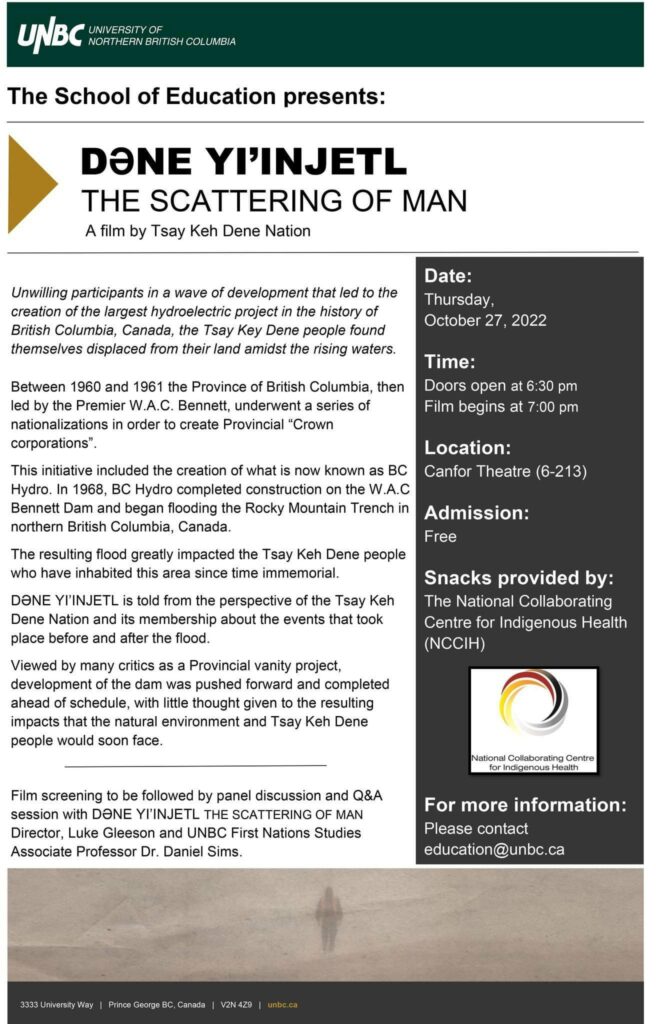
(Picture from : UNBC Twitter)
On October 27th, our EDUC 405 class dedicated their class to viewing “DƏNE YI’INJETL – The Scattering of Man” directed by Luke Gleeson. This film was produced to showcase the Tsay Keh Dene Nation and allow them to tell their story, culture, and their experiences caused by the devastating impacts of the W.A.C. Bennett Dam.
The film discussed the issue of the Band being unaware of the creation of the dam. They were not consulted in the creation of the dam or had any information given to them throughout the process of planning and construction. Those in charge of the dams project, did not reach out to the Band to provide any relief such as living situations or accommodations. The lack of care or compassion left the Nation to have no other choice but to relocate as quickly as they could due to unliveable conditions due to fast water levels rising. Wildlife was dying and the effects became visible to the Band, in addition B.C hydro had left unclaimed wood from the project and forced the Band to deal with. In Indigenous culture Elders are highly respected and keeping their legacy alive is very important. With that being said, there were promises made to the Nation that made sure the graves of their ancestors would be taken care of but no promises were kept. What once was the humble village of the hard working Tsey Keh Dene Nation was now a memory as it sat below the water. The livelihood of these people were not taken into account. It seemed as though the dam was more important than our own people.
There were many takeaways from this film, some that stood out were :
– Throughout the film we witnessed many interviewes of people from the Tsay Keh Dene Nation who experienced this battle first hand. This put a face to the story. It showed that this situation happened to real people. Real lives were affected. It made the film very impactful by hearing their stories and experience.
– Beautiful scenery shots that overlooked mountains, water, trees, etc were shown throughout the film. This to me demonstrated the idea of “calm before the storm,” showing that the beauty of nature that once was, was no longer as natural or beautiful due to the takeover of the land.
– There were moments shown of heavy machinery cutting down trees, the dam itself, or cleared land that once was abundant with lush trees. These scenes symbolized the impacts of the project of the dam as well as the outcomes of what our world will look like if we keep destroying our land.
This film left an impact. The Nation faced something that many are privileged enough to not have to go through. When watching the film I recognized my privilege and really tried to put myself in their shoes and understand truly what they experienced. Although I will never truly know the pain they felt and the difficulties they faced, I believe it is important to listen and understand their perspectives and life stories. Indigenous peoples have had many challenges throughout this life, and we need to step up and understand that the Tsay Keh Dene Nation’s situation is one of many and we need to prevent inequality for future generations.
This film showed how powerful and connected Indigenous culture is and I have so much respect for their fight and determination through their struggles. Mentioned in the film, it was said that “we are keepers of the land, we take from it but we also give back to it” (Documentary) and I believe that everyone should live life by that statement. We are so grateful to be living on this land, we need to stop being greedy and taking without giving anything back. This film was a truly eyeopening experience.